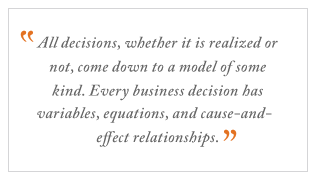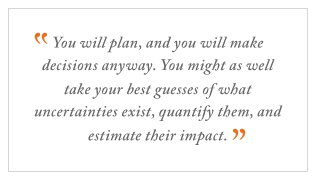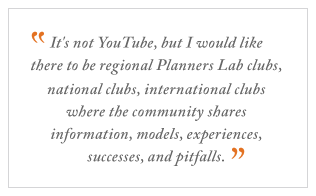The reason that decision makers are often the most powerful and well-paid people in business is because decision making is inherently difficult and risky. Analyzing a multitude of probabilities takes skill, experience, and courage. And it especially involves the analysis of cause-and-effect relationships. None of this is easy.
 |
We all know that what goes up must come down. But in fact, most of us don't -- at least not in a practical way, says Gerald R. Wagner, Ph.D., Distinguished Research Fellow at the Peter Kiewit Institute at the University of Nebraska-Omaha (UNO), the founder of several software companies, and a widely recognized expert in data visualization and decision-support technology.
Dr. Wagner has spent his career trying to understand decision making and decision makers. He has come to the conclusion that most businesspeople, in fact most people, don't understand the rules of cause and effect as they apply to decision making. Computer models, however, can be made to do just that.
Dr. Wagner's latest venture is a software program called the Planners Lab, created with UNO student interns. The software helps users build decision-making models by allowing them to input their assumptions in their own language and to meet their own needs. Then the program evaluates and analyzes cause and effect. It's a spare brain with tremendous analytical skill.
In this interview, Dr. Wagner discusses why humans can't comprehend complex probabilities, why businesses need models to make informed decisions, why he chose Planners Lab as the capstone to a highly successful career -- and why he's releasing the software to a limited audience -- for now.
GMJ: You used to do a lot of work with group decision-support software, but you're not involved much with group decision making these days, right?
Dr. Wagner: That is right. It just did not accomplish much. I've done hundreds of these sessions, and they're fun. I've facilitated everything from the naming of new products to corporate strategic planning. You may bring in employees or customers, and you might learn something from them, but in the end, a few key people make the final call.
So even though these sessions were fun for everyone and ended up with really impressive final reports, I don't think much ever came of them. That's probably why group decision making went out of fashion. But, collaboration per se is a different issue.
GMJ: What do you mean by "collaboration"?
Wagner: I recently spent a week in Washington, D.C., at a conference on creativity and cognition, and almost every presenter talked about collaboration and the importance of it -- not in the old group decision-support system style, but collaboration in general. It's a problem that many people are still coping with, but we haven't made much progress in providing technology to assist the collaboration process.
The kinds of technology we do have are pretty trivial. You can do brainstorming with paper and pencil, and you can do it with flipcharts -- you don't need software, which essentially is replacing what was already being done. It's paving the old cow trail rather than coming up with something new and inventive. But some things we're working on now -- modeling and visualization -- are far more encouraging.
GMJ: Models for what?
Wagner: Business models. For budgeting purposes, investment purposes, strategic planning, purchasing planning, whatever the case may be, but mostly it's for business activities. All decisions, whether it is realized or not, come down to a model of some kind. Every business decision has variables, equations, and cause-and-effect relationships, so underlying anybody's thinking process is a model. They may not know it -- it probably isn't explicit -- but it's there.
If you're putting together your personal budget, you're thinking about the loan on your house, the payment on your car, food and medical [expenses], etc. There's a complicated dynamic. In business, it's somewhat more complicated. There are cause-and-effect relationships between those variables. If I increase this one, for example, it will have an impact somewhere else. If I increase that one, it will have an impact somewhere else.
Well, when you start to think about that sort of thing, it becomes more complicated than the human mind can handle. So we're developing modeling languages that help the end user identify and write out those types of relationships one at a time and in their own words. Once they've done that, then our software supports them with visualization tools -- with interactive charts and graphs and engaging animations. So the user can ask, "Well, if I change this number, what impact does it have on these other numbers?"
GMJ: So, say I'm wondering if I should switch vendors; one says he'll give me a 5% discount, but the one I have does things we'd have to pay another vendor to do. But that might not always be true. The first vendor might raise prices. So you can write all of this stuff on a piece of paper, then turn it into a computer model?
Wagner: Yes.
 |
GMJ: How do you do that?
Wagner: Well, if the discount is 5%, you have a variable that says the first vendor's discount is equal to .05. So you explicitly define that variable, plus the cost of what the other vendor is doing, plus all the other variables involved -- these tools help you to describe and include every little piece -- and you end up with a complete model. The human mind is not capable of handling all those variables at one time. The model is.
When I talked about the variables in the equations, what that really means is a list of assumptions. And that list of assumptions can be understood by anybody on the team because it's written in their own words. The assumptions are made explicit in their [team members'] own terminology, whether they're a financial analyst, salesman, CEO, or whatever.
GMJ: Can more than one person be involved?
Wagner: The model provides a way for everybody to see what the assumptions are, so it becomes a very active collaborative process. For example, if you don't believe a number, we can change it, and everyone sees what effect it has on the overall decision we're trying to make. It's a way to arrive at a consensus based on explicit information rather than just confusing conversation.
GMJ: So the technology you're developing not only lists all the variables and all the assumptions, but it does it in a language that's endemic to whatever community is involved, because I'm sure accountants speak differently than surgeons do . . .
Wagner: Yes, that's right.
GMJ: . . . and it makes it graphical . . .
Wagner: Yes.
GMJ: . . . which is easier for people to understand . . .
Wagner: Right.
GMJ: . . . and it's easily accessible by everybody in the community or on the team.
Wagner: Yes.
GMJ: What technology is used to make decisions? How is it currently done?
Wagner: The default standard is Excel. With Excel, you can change one cell in a row and have no idea what impact that will have somewhere else. Everything is hidden behind the numbers in a matrix cell. Literally, million-dollar mistakes have been made because of a small mistake in programming an Excel spreadsheet.
Excel is good in terms of being an electronic calculator, but it's not very good for thinking about the future. It's a cryptic programming language. It also is not interactive [and doesn't provide] instant and understandable feedback. So, [for example,] if a project team must make a recommendation of whether or not to buy a new piece of equipment, they put their data into Excel. Then they go into the meeting, make their presentation, and the executive asks, "Well, what if this happens rather than this?" Usually the meeting is adjourned, the financial analyst goes back to his or her desk, finds the answer, reschedules another meeting, comes back, and answers the question that was asked.
Obviously, that takes a lot of time. With our technology, questions can be answered on the spot, and the executive can read the team's assumptions in its own words just like it was a story. This is visual storytelling.
GMJ: And the assumptions can be agreed on by everybody.
Wagner: Well, they don't necessarily have to be agreed on, but at least everyone knows what they are.
GMJ: Considering that many people are in an uncertain environment, and it's more difficult than we'd like to think to predict the future, how can anyone really plan effectively?
Wagner: You will plan, and you will make decisions anyway. You might as well take your best guesses of what uncertainties exist, quantify them, and estimate their impact. We've experienced "illumination" a number of times in the various tests we've run. We bring in a team to model an application. They come in with different ideas of what the assumptions and data are and even what the problem is. Then they see this start to unfold -- this only takes about an hour, by the way -- and they're just amazed at how they could have had such varied differences of opinion about what the assumptions are. It never fails; it always happens when we do testing. If we can help them to understand their business and the assumptions underlying their business [model], I have to believe that's a contribution.
GMJ: So is this technology available to business?
Wagner: It is available now, but we are not outwardly pursuing business users at this time. First, we will go live on December 15, 2007, and make the software available to university students and professors. Business school, public administration, information systems, and engineering students are the likeliest candidates [to use this software]. This is meant to support an academic community first, and if there's commercial interest, we'll make it available.
 |
GMJ: Why aren't you selling it to the general public now? Why wait?
Wagner: I've started companies before with venture capital money, and venture capital is needed to put together a sales and marketing organization. It's a lot of stress and a lot of work, and I don't want to do it again. Also, the Planners Lab is perceived as a direct competitor to Excel, and Excel users are entrenched. They won't change.
Classroom use, however, builds a base of people who are not yet entrenched with Excel, such as students. This approach builds a large community of users who then turn it into a commercial market. If we focus on getting technology into university classrooms, and I believe 400 to 500 professors will be using this in five years, going commercial will be much easier down the road. Furthermore, we want the software to be surrounded by a community [that provides an element] of social interaction, and that is most appealing to young people. That's what students want, and it fits this approach. We want to overwhelm them with social interaction and sharing opportunities. We want to tap into that massive resource of innovation and creativity.
I've spent my life and my work on the importance of being able to communicate and understand assumptions. My motivation at my point in life is to touch the largest number of people who will take my beliefs and philosophy to heart, such as open-minded students.
It's not YouTube, but I would like there to be regional Planners Lab clubs, national clubs, international clubs where the community shares information, models, experiences, successes, pitfalls, etc. Working with the software is fun stuff. And we see it all the time -- people become addicted to it.
GMJ: Is that a variable you planned for?
Wagner: It was, perhaps, an assumption.
-- Interviewed by Jennifer Robison